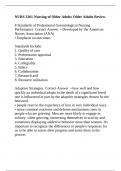NURS 3261-Nursing of Older Adults Older Adults Review
8 Standards of Professional Gerontological Nursing
Performance Correct Answer • Developed by the American
Nurses Association (ANA)
• Emphasis on outcomes
Standards Include:
1. Quality of care
2. Performance appraisal
3. Education
4. Collegiality
5. Ethics
6. Collaboration
7. Research and
8. Resource utilization
Adaptive Strategies Correct Answer • how well and how
quickly an individual adapts to the death of a significant loved
one is influenced in part by the adaptive strategies chosen by the
bereaved.
• people react to the experience of loss in very individual ways.
• some common reactions and defense mechanisms seen in
people who are grieving. Men are more likely to engage in
solitary, silent grieving, immersing themselves in activity and
sometimes displaying addictive behavior more than women. It's
important to recognize the differences in people's responses for
us to be able to assess their progress and assist them in the
process
,Adverse Drug Reactions in the Older Adult Correct Answer •
Adverse drug reactions are the fifth leading cause of death in
older adults.
• They may suffer falls from orthostatic hypotension due to the
medications they are taking.
• Some drugs may have side effects that cause confusion,
especially if inappropriate doses have been taken or prescribed.
• Hepatic or renal toxicity can cause major acute medical
problems.
• Sometimes, adverse drug reactions aren't recognized by
healthcare professionals because they may simulate the
conventional image of growing old → unsteadiness, confusion,
incontinence, depression. All of these can be caused by drug
reactions, and that is the first area to explore when evaluating
the patient. This is an area where stereotyping of the older
person can prevent in-depth assessment.
• The patient's role in adverse drug events may have to do with
his or her ability to correctly take his medications. Visual
problems, arthritis, illiteracy, or impaired cognition can all make
it difficult for an elderly person to self-administer his or her own
medications.
• Some patients can't afford to fill their prescriptions, so they
skip or halve doses, or even share with a spouse. If finances are
tight, they may choose to buy food before purchasing their
medications.
• Referral to social services for financial assistance is another
way to help patients in financial distress obtain their
medications.
,Ageism Correct Answer The process of systematic
stereotyping, discrimination, or prejudice against persons based
on the characteristic of age.
Aging, Demographics Correct Answer • 12.4 percent of the
population of the United States was over the age of 65 in 2006
according to the U.S. Department of Health and Human
Services.
• Our society is aging because fertility rates in the U.S are
falling, and our life expectancy is increasing.
• Life expectancy is a measure of the overall health status of a
population.
• In 1900, the average lifespan for an American was about 40
years. In 2010, the projected life expectancy in the U.S. is
expected to be 77.4 years.
Alternatives for Limiting Restraints Correct Answer • find out
why he's agitated and try to treat the cause.
• think about the risks of restraints.
• using partial bedrails and floor mats with the bed in the lowest
position may make more sense than risking a fall as the patient
crawls out over the footboard.
Alzheimer's Disease Correct Answer • progressive and
irreversible
• begins with the early stages in which a person might have mild
memory impairment, forgetting names, or losing familiar
objects.
• medication is available to slow down the progression of the
disease, ebut ventually the patient, if he or she doesn't die from
another cause, will lose the ability to walk, talk, or eat.
, Analgesic Ladder Correct Answer • In 1986, the World Health
Organization (WHO) first proposed that health professionals use
analgesic medications via a systematic plan.
• The systematic plan includes a three-step ladder approach
relevant to pain management for all types of pain, including pain
at end of life.
Baby Boomers Correct Answer • Cohort born between 1946
and 1964.
• There are 74.1 million people in this generation!
• The first baby boomer just applied for Social Security in 2008
at the age of 62.
• By the year 2030, it is predicted that 1 out of 5 people will be
over the age of 65, with 1 out of 8 over 85.
• As the boomers enter the picture, the average level of
education will increase.
• This group will be computer savvy and have more knowledge
about their health than any other generation.
• Obesity and positive HIV status will be problems.
• This group will see increasing institutionalization as they age,
and gay seniors will become an emerging trend.
Care, End of Life Correct Answer • 90% of Americans
surveyed in a recent Gallup Poll said they wanted to die at
home.
• 74% died in institutions, including 57% in acute care hospitals.
• Palliative care, which is underutilized in the U.S., is available
for persons who are not imminently terminal but need help with
the quality of life. The focus of palliative care is symptom
control, including pain, and care for psychological, social, and




